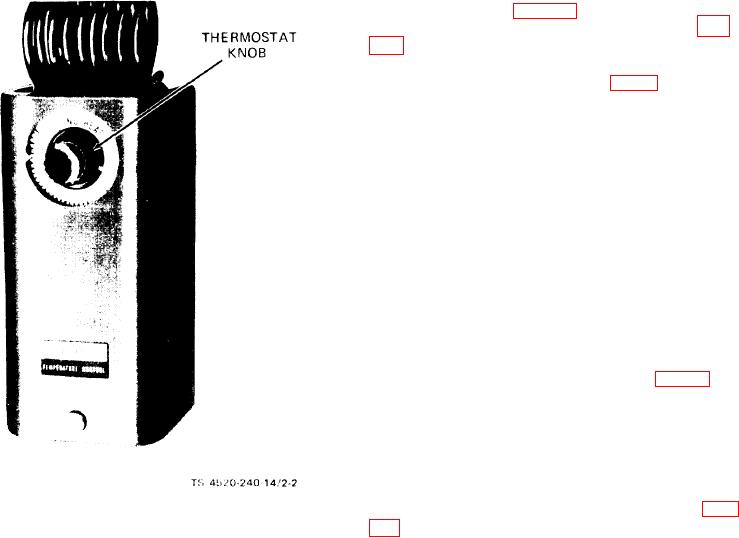
TM 5-4520-240-14
and services given in table 3-1.
(2) Check the setting of the thermostat knob (fig.
2-2). If necessary, adjust knob to the desired setting.
b. Starting Procedure.
(1) Place the ON-OFF switch (6, fig. 2-1) in the ON
position. The heater will operate under control of the
room thermostat, starting as the thermostat calls for
heat, and stopping as the heat requirement is satisfied.
While the heater runs, the blower circulates warm air
in the enclosure.
(2) If the heater stops after a short time, check for
an inadequate fuel supply and replenish if necessary.
Allow 3 to 5 minutes for the time delay mechanism to
cool, then press the RESET switch (5, fig. 2-l), and start
the heater in the normal manner.
2-4. Operation.
a. After starting, the heater will run without opera-
tor control, cycling on and off under control of the room
thermostat.
b. If the temperature in the enclosure becomes too
high or too low, adjust the thermostat knob (fig, 2-2) to
compensate,
c. If the type of fuel being used is changed from one
operating period to another, the heater may smoke or
operate erratically. Report the condition to organiza-
tional maintenance for adjustment.
2-5. Stopping.
a. To stop the heater, turn the ON-OFF switch (6, fig.
Figure 2-2. Room thermostat.
2-1) to OFF.
2-3. Starting.
CAUTION
WARNING
Do not disconnect the power cable con-
Do not operate this heater in an
nector or interrupt the electrical sup-
enclosure unless exhaust gases are
ply to the heater until it shuts down
piped outside of the enclosure. The ex-
after the purge cycle is completed.
haust gases contain carbon monoxide,
b. If the heater is operating at the time of shutoff,
a colorless, odorless, deadly poisonous
the blower motor will continue to run and the burner
gas. Failure to provide proper elimina-
will continue to burn until all fuel has been purged
tion of the exhaust will cause severe
from the heater. When the fuel is burned and the
illness or death.
a. Preparation for Starting.
heater has cooled sufficiently, the heater will shut
(1) Perform the preventive maintenance checks
down.
Section Il. OPERATION UNDER UNUSUAL CONDITIONS
2-6. Operation in Extreme Cold (Below
them from entering fuel tank, causing freezing in fuel
10F) (-12.2C).
lines.
A thermostatically controlled fuel heater automat-
2-7. Operation at High Altitudes.
ically heats the fuel when the temperature drops below
a. The heater is designed to operate at elevations up
40 6F (l.1 to 7.8C). This preheating of the fuel aids
to 10,000 feet above sea level without special service or
combustion and ignition during extreme] y cold condi-
adjustment.
tions. No operating procedures are required for this
fuel heater. You should take the following steps during
b. At 10,000-foot altitude, heat output may be
reduced approximately 15 percent. This is a normal
extremely cold conditions
a. Keep the fuel tank full to prevent condensation of
condition which cannot be prevented, but optimum per-
moisture in the tank.
formance can be obtained by following all service in-
b. Clean snow and ice from fuel tank filler to prevent
structions carefully.
2-3

